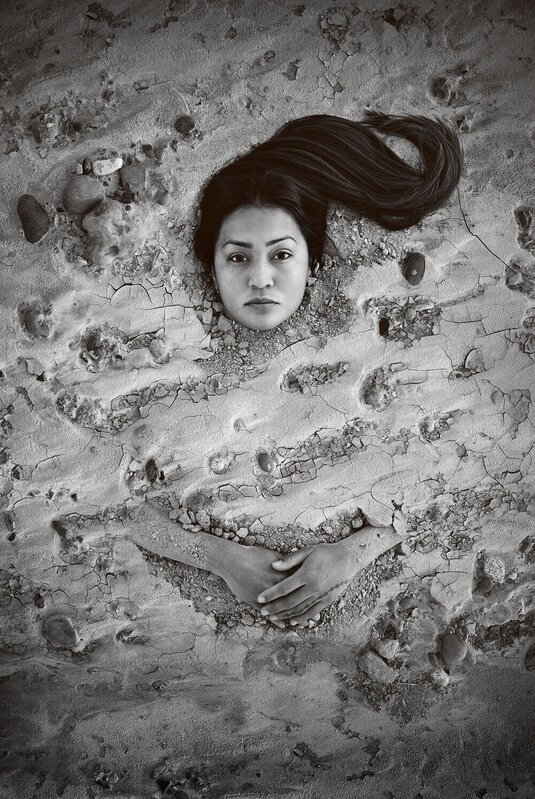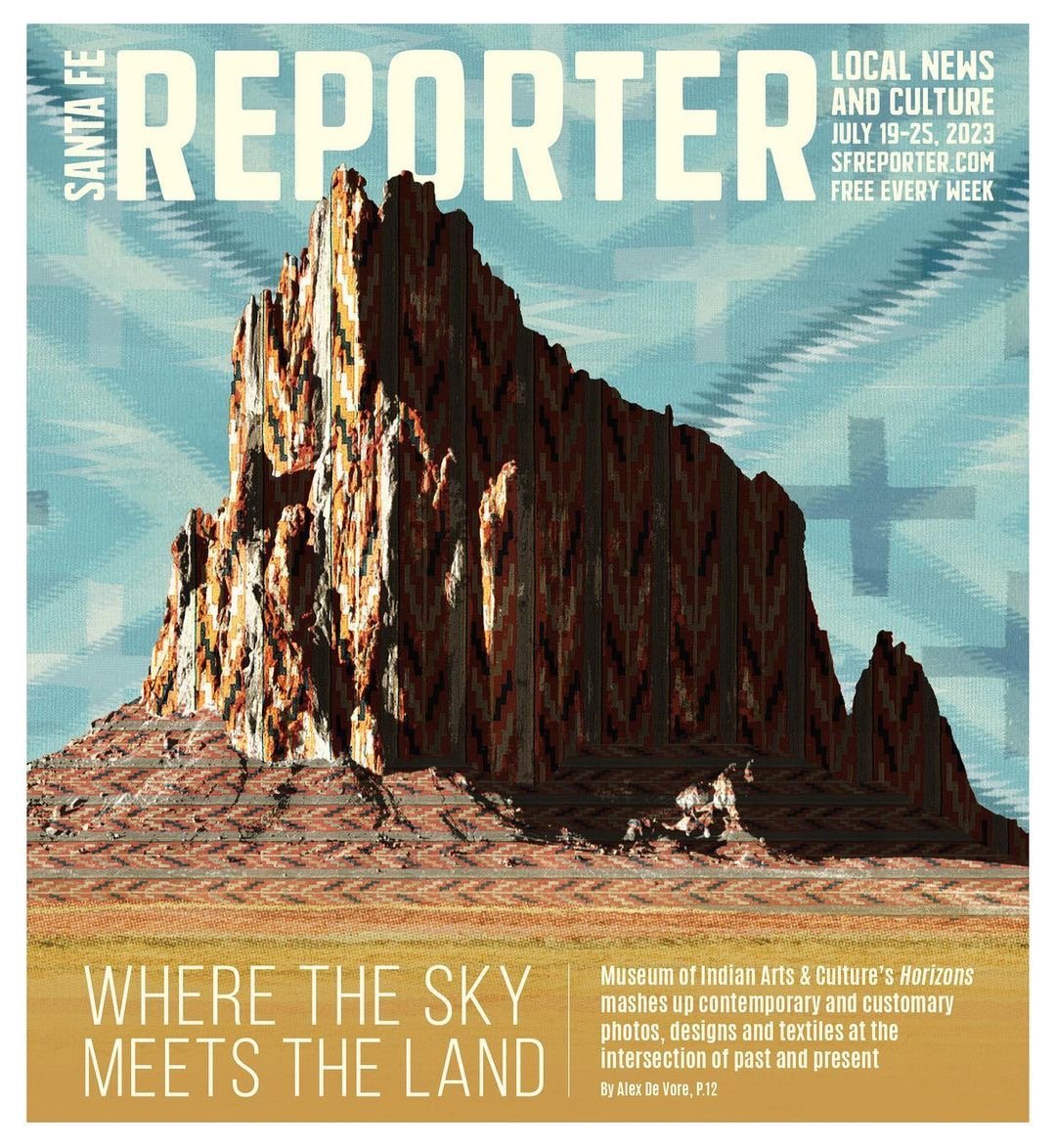Upcoming Publications
Making in Between: Indigenous Americans
American Museum of Ceramic Art, Curated by Pam Aliaga, Los Angeles, CA, May 24, 2025–November 30, 2025
Prospect.6: The Future is Present, The Harbinger is Home
Prospect New Orleans Triennial, Curated by Susan Brennan, Co-Artistic Directors Miranda Lash and Ebony G. Patterson, New Orleans, LA, November 2, 2024—February 2, 2025
Memories of a Suburban Ind'n | John Feodorov
Western Gallery, Western Washington University, Curated by Faith Brower, Bellingham, WA, September 25, 2024—December 7, 2024
Academic Publications
Body, Spirit, Land: Critical Indigenous Theory Imagined by Sky Hopinka
you are here: the journal of creative geography, School of Geography, Development & Environment, University of Arizona, 2024
The editors of the 2024 issue, mapping all my relations. In this article, Larissa explores the film, Cloudless Blue Egress of Summer, by Sky Hopinka (Ho-Chunk/Pechanga) through the lens of critical Indigenous theory. By analyzing the thematic concept and subject of the film, she traces an interrogation of settler colonialism but also reveals how the presence of memory lingers through material culture and mirrors itself with relationships to land.
The Aesthetic of Power: Porcelain and the Expansion of White Saviorism
Spark: Elevating Scholarship on Social Issues, National Center for Institutional Diversity, University of Michigan, 2021
The co-authors of this paper, Larissa Nez, Sophia Ellis and Rai Terry, examine kaolin, the essential ingredient in porcelain which enthralled the western imagination in the 16th-18th centuries, and its relationship to settler-colonialism, European bourgeois aesthetics, and abolitionism movements.
Museum Publications
“Reuniting & Returning: Balancing our Universe through Weaving”
in Horizons: Weaving Between the Lines with Diné Textiles, ed. Hadley Welch Jensen. Museum of New Mexico Press, 2024
Larissa’s essay explores the ways that Diné women were explicitly affected by new colonial economies that negatively impacted the ways weavings were configured, and disfigured, from the mid-twentieth century onwards. Her insights include a historical analysis of trading post economies, cultural beliefs around Diné weaving and feminism, and future implications for museums who seek to restore Diné autonomy in their spaces.
Shaped by the Loom: Dyeing & Coloring Educator Guide
Bard Graduate Center, 2023
In Spring 2023, Larissa was commissioned by Bard Graduate Center to be the lead author for Shaped by the Loom’s educator guide. This educator guide is designed for teachers and students in grades 4–6 as a complement to the exhibition Shaped by the Loom: Weaving Worlds in the American Southwest (organized by Bard Graduate Center Gallery, New York, 2023, and curated by Hadley Welch Jensen alongside a team of collaborators). By highlighting the collective knowledge that guides the making process, the exhibition presents weaving as an art form, a cultural practice, and a lived experience.
“Indigenous Power in Public Places”
in Jaune Quick-To-See Smith: Memory Map, ed. by Beth Huseman. The Whitney Museum of American Art, 2023
Larissa authored catalogue entry provides a historical scope and formal analysis on the Petroglyph Park series featured in the exhibition, Jaune Quick-to-See Smith: Memory Map.
“The Aesthetics and Ethics of Representation, Reclamation, and Resistance: The Art of Jaune Quick-to-See Smith”
in Poetic Justice: Judith F. Baca, Mildred Howard, and Jaune Quick-to See-Smith, ed. by Merry Scully. Museum of New Mexico Press, Forthcoming in 2024.
Larissa’s academic essay focused on the artistic growth and impact of Jaune Quick-to-See Smith. Her insights provided an expansive theoretical analysis on the formal qualities, technique, and inspiration behind major works featured in the exhibition.
Stories and Editorials
Indigenous Cultural Revitalization: Notes on rematriation and preservation
Arts of the Working Class, July 2023
In this issue, '“On Kinships: I’D RATHER GATHER IN ANYTHING BUT A NATION,” contributors summon forms of affiliations that are more than biological or nation-inscribed, move into joyful fugitiveness, and model of relational world-making. Larissa authored and edited a piece for the issue that focused on Indigenous cultural revitalization, repatriation, and preservation.
Finding Our Way Past Trading Posts
Asparagus Magazine, July 2022
In the last issue of 2021 and the first special issue by Asparagus Magazine, Larissa wrote a First Voice essay reflecting on how trading posts in the Southwestern US harmed—and continue to harm—local Indigenous communities by commodifying items of personal, familiar, and spiritual value.
A Letter to My Freshman Self
Corby Books, September 2021
A Letter to My Freshman Self is an anthology of personal letters from University of Notre Dame’s alumni and present day students to their freshman selves. Speaking from diverse perspectives, the authors pass on their unique stories, compelling journeys, and powerful reflections to help freshmen make the most out of their college experience.
Be The Light, Vol. 4 / ND Family Doing Good During the Pandemic
We Are ND, April 2020
Notre Dame alumni, parents, and friends continue to be forces for good in the fight to end the COVID-19 pandemic and support the vulnerable during this challenging moment in time. Larissa’s efforts on the Navajo Nation are featured.
The Exploitation of Native Imagery for Profit
Terra Incognita Media, September 2017
This publication highlights the history of Native imagery being utilized in art, the development and portrayal of Native activism in the media, the issues of Native mascots in sports, and the exploitation of Native imagery for and by capitalism.
Creative Writing
"Smith presents a complex composition that reframes the way we understand temporal experiences of war: For those who terrorize, war is a lucrative endeavor that is intimately bound to capitalism and power. For those who are terrorized by this violence, how do they move forward? What existence is possible in its aftermath?"
“Our collective project is not to simply learn about one another’s histories and lands. Our project is to move gently across the land so that our senses are attuned to the heartbeat, spirit, breath, and movement of the land. Our project is to know the land as beautifully and intimately as the Holy People, Changing Woman, and our ancestors did. Our project is to express a deep love for the land and in that love, defend, care, and listen to the land. Just as the land knew us before we entered this world—through our actions and love, the land will see us in and know us through future generations.”
"The wall in the gallery that had been neatly arranged with an “accumulation of dishonorable Indigenous stereotypes” became sparse and slowly, every item was transformed through the cathartic act of destruction. Destruction, then, was the vehicle in which community and ceremony were activated."
“We have our own stories. Our stories restore life, beauty, and balance to the world. Our stories guide us in imagining and fighting for a decolonial future. Our stories were passed down to us by our Holy People. We do not seek recognition through our stories, we seek revolution through Our Stories.”
Features
“I think there’s a balance… [and] these relationships to weaving are translated into the exhibit. The work we wanted to see is grounded in having people understand the human aspect, the community aspect of weaving. And now we want that to continue in our own work.”“The [Color Riot!] installation in Montclair adds many new elements, including immersive, atmospheric music by Diné musician Connor Chee. Visitors to Color Riot! will have the opportunity to see the resilience, autonomy, and ingenuity woven into these textiles along with the beautiful colours.” — Christie’sA Diné Horizon, Museum of New Mexico Foundation, El Palacio, Summer 2023
Montclair Art Museum Presents "Color Riot! How Color Changed Navajo Textiles", New Jersey Stage, July 2021
As COVID highlights health inequities, pueblos prioritize local agriculture, NM Political Reporter, June 2020
How to Support Indigenous Organizers Fighting Coronavirus in Native American Communities, Teen Vogue, April 2020
Revisions: Contemporary Native Art, Artsy.net, April 2019
Exhibit at Notre Dame's Snite Museum showcases current Native American artists, South Bend Tribune, March 2019
Representation matters at ‘Revision: Contemporary Native Art’, The Observer, February 2019
Seminars, Panels, & Symposia
Re-Visioning Native Histories
VLC Forum 2024, October 2024
In an expansive conversation, VLC Borderlands Curatorial Fellow Larissa Nez (Diné) introduces Kent Monkman (Cree) and Nathan Young (Delaware Tribe of Indians) and moderates the conversation to ask: How can artists and historians correct or produce a “correct” record of Indigenous histories? How can historical scholarship and artistic practice work in tandem to reenvision Native pasts and futures? revisit some of the foundational narratives of the so-called United States of America, centering Indigenous figures, events, and narratives that have been erased or denied as part of the settler-colonial project.
Seminar 11: Many Returns
Vera List Center for Art and Politics, March 2024
Convening this seminar as the Borderlands Curatorial Fellow, Larissa takes up questions around restitution and rematriation, or more specifically, land back and return from Indigenous perspectives, from Turtle Island to Palestine alongside the two featured speakers.
Seminar 6: Indigenous Cultural Revitalization: Rematriation and Preservation
Vera List Center for Art and Politics, May 2023
Convening this seminar as the Borderlands Curatorial Fellow, Larissa considers rematriation and the preservation of Indigenous culture, art, and land. With an emphasis on culture as a living process that incorporates both continuity and change, this seminar explores the ways Indigenous people from, and living in, the New York region are working across social and political landscapes to revitalize traditional practices, language usage, and artistic experimentation.
Larissa Nez — On Decolonizing Institutions
Fields of the Future: Unraveling the Loom podcast, Bard Graduate Center, Fall 2022
Larissa is a featured guest on the Fields of the Future: Unraveling the Loom podcast hosted by the Bard Graduate Center, a graduate research institute in New York City. Larissa discusses her relationship to Navajo weaving and culture while connecting it to her curatorial work and education.
Rug and Textile Appreciation Morning: Color Riot! How Color Changed Navajo Textiles
George Washington University Museum and The Textile Museum, April 2022
Through a virtual tour moderated by Laura Allen, weaver Velma Kee Craig, one of the three Diné curators of the original exhibition, will speak closely to the stunning textiles selected and the exhibition's themes. Larissa Nez (Diné), a contributing curator for the Montclair installation, will share additional community and artistic perspectives on weaving.
Ecologies of Making: Knowledge and Process in Navajo Weaving
Shaped by the Loom: Weaving Worlds in the American Southwest, Bard Graduate Center, February 2023
Larissa shared a research paper titled, “We Are Alive: Restoring Meaning and Life to Navajo Weavings,” along with presentations given by four Diné scholars, weavers, and artists at a research symposium in conjunction with the Shaped by the Loom exhibition opening events.
Indigenous Histories in New England
Center for the Study of Slavery and Justice, Brown University, April 2022
A research presentation by Mellon Graduate fellows at the Center for the Study of Slavery & Justice. These presentations reflect on graduate fellows participation on the Reimagining New England Histories (RENH) -a collaborative project with Williams College, Mystic Seaport Museum, as well as Indigenous and African American communities that seeks to tell the complex plurality of histories of these communities within the region of New England.
The Public History of King Philip's War: A Panel Discussion
Wayland Public Library, October 17, 2021
"The Sudbury Fight," "King Philip's Woods," "Metacomet Way." What comes to mind when you hear these terms and place names? What really was King Philip's War and how do we understand it's significance in our history?
Join us for a panel discussion on the history and impact of the violence, how it has been remembered through memorials and markers, and recent efforts to center a Native American perspective in our public memory of King Philip's War.
Interrupting Oppression in the Outdoors Workshop Series
Terra Incognita Media, Portland, OR, 2017
Larissa was a co-facilitator for the 2017 Interrupting Oppression workshops hosted by Terra Incognita Media in Portland, OR. In these early workshops, the Terra Incognita Media team linked the patriarchy, toxic masculinity, and capitalism back to colonization and how the outdoor industry co-signs and directly contributes to the ongoing oppression of marginalized communities.
















